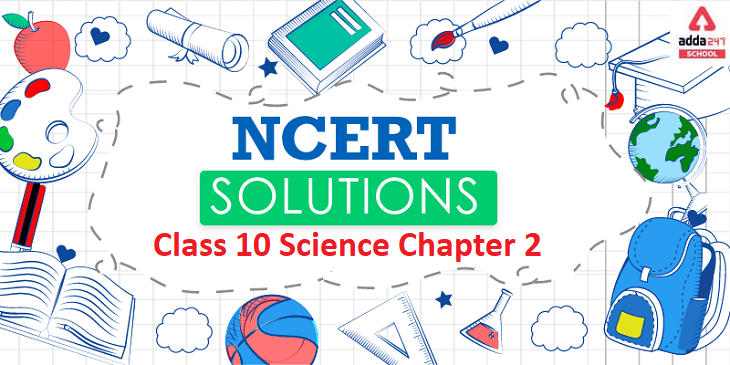NCERT Solutions for Class 10 Science Chapter 2: Acids, Bases and Salts
Adda247 provides NCERT Solutions for class 10 Science. The NCERT Solutions provided here will enhance the concepts of the students, as well as suggest alternative methods to solve particular problems to the teachers.
Chemistry is much more than the language of Science. We aim to aid the students with answering the questions correctly using logical approach and methodology. The NCERT Solutions provide ample material to enable students to form a good base with the fundamentals of the subject.
Class 10 board examination is the most crucial exam in every students’ life. Their future studies and career depend on the mark secured in the board exams. Every student works hard to score well in class 10 CBSE examinations. Science among all the subjects of class 10 has a vital role in every student’s career. Science teaches us how the world and our environment is made. The students can secure better marks in the science subject if they want to become a doctor or an engineer in future. It is important that they should prepare and study hard for this subject so they don’t lose marks.
For the students in Class 10 Science is a great book to refer to. The Class 10 Science Solutions are available chapter-wise at Adda247 and can prove to be very useful for the students. Whether you are struggling to grasp the concepts of various topics in the chapters or willing to push yourself to score better in the exams, NCERT Solutions for Class 10 Science PDF is the answer for you. These solutions are provided in an easy-to-understand language and will promote self-learning among students. The CBSE Class 10 Science Solutions, available for all the chapters, encourage a spirit of learning among students. Can learn all the chapters by following the NCERT Science Class 10 Solutions without even having to step out of their homes.
Adda247 provides the downloadable PDF of NCERT Solutions for Class 10 Science absolutely free of cost. All you need to do is register on the site and download the file. At Adda247, these solutions are designed by subject matter experts who have immense knowledge and experience. These are designed as per the latest NCERT guidelines and exam pattern to make it a reliable material for exam preparation.
While solving the textbook questions, students often find doubts and get confused. The NCERT Solutions for Class 10 come in handy at such times, as they include precise explanations and detailed answers to those questions. These CBSE Class 10 Science NCERT Solutions cover solutions to all the important chapters included in the textbook-like Matter, Atom, tissues, Living Organisms, Motion, Force, Law of Motion, Gravitation, Energy and work, Sound, Natural Resources, etc.
Along with answers to the textbook questions, these solutions provide you extra questions, exemplar problems, their solutions as well as tips and tricks.
Read: NCERT Solutions for Class 10 Science Chapter 1
NCERT Solutions Class 10 Science Chapter 2 Acids, Bases, and Salts Pdf Download
Acids, Bases and Salts are prepared to help students in their CBSE term I exam Preparation. This solution provides you with answers to the questions provided in the NCERT Class 10 textbooks. To score better marks in the Class 10 Science Term I examination students should get well marks with the NCERT Solutions for class 10 Science provided here.
CLICK Here! To Download Full NCERT Solutions Class 10 Science Chapter 2 PDF
Benefits of NCERT Solutions for Science Class 10 Chapter 2
The benefits of Class 10 Science solutions are endless and will clear doubts for every candidate, as all prospective questions on these topics are answered here.
- NCERT Solutions for Class 10th Science provides a clear insight into combustion and flame.
- The solutions are given into simple language and can be understood by all students.
- The solutions are given by experts.
- All the topics that can appear in the exams are covered thoroughly in these solutions for the students to gain more marks in the examination.
Class 10 Science Ncert Solutions for Chapter 2 Acids, Bases and Salts
An acid is defined as a substance whose water solution tastes sour, turns blue litmus red and neutralizes bases. … Salt is a neutral substance whose aqueous solution does not affect litmus. According to Faraday: acids, bases, and salts are termed as electrolytes
Uses of Acids and Bases
Uses of Acids. Vinegar, a diluted solution of acetic acid, has various household applications. It is primarily used as a food preservative. …
Uses of Bases. The manufacturing of soap and paper involves the use of sodium hydroxide. NaOH is also used in the manufacture of rayon.
Acids, bases and salts affect chemistry as well as our day to day life. They can be easily identified by their taste; that is acids taste sour and bases taste bitter and salts itself have salty taste.
When weak acid reacts with a strong base, then basic salt is formed.
…
| ACIDS | BASES |
| Acid are those that can donate electrons | Bases are those that can accept protons |
| The pH values of acids are basically less than 7 | The pH values of bases are basically more than 7. |
| Acids turn blue litmus red. | The Base turns red litmus blue. |
Acids and bases are important in living things because most enzymes can do their job only at a certain level of acidity. Cells secrete acids and bases to maintain the proper pH for enzymes to work. For example, every time you digest food, acids and bases are at work in your digestive system.
In every-day life, acids and bases play a role in everything from digestion of the foods you eat to the function of the medicine you take and even the cleaning products you use. Without acids and bases, many of the products in your home today would not have much use.
In general, acids are sour/tart, feel like water, may sting when touched, react strongly with metals, conduct electricity since they ionize in solutions, and turn blue litmus paper red. Bases are bitter, slippery and smooth, do not react with metals usually, conduct electricity, and turn red litmus paper blue.
Acids are the substances which are sour in taste. Bases are the substances which are bitter in taste. … And bases are the substances which gives OH-ion when combine with water. Acids are the substances whose pH is in between 0-7 and bases are the s whose pH is in between 7-14.
In industry, acids and bases are used in various reactions. Sulphuric acid, one of the most important industrial chemicals, is used to manufacture fertilizers for agriculture, to make man-made fibers, paints and dyes, and to purify petroleum products.
Examples of Everyday Bases
Drain cleaner.
Laundry detergent.
Lubricating grease.
Alkaline batteries.
Soaps and bath products.
Sugar.
Baking soda.
You can find acids and bases in your own home in the form of food and household products.
Citrus Fruits. ••• Oranges and lemons, for instance, contain citric acid, which makes them acidic home products.
Toothpaste.
Vinegar.
Carbonated Beverages.
Baking Soda.
Cleaning Powders.
Soap.
Ammonia.
The range goes from 0 – 14, with 7 being neutral. pHs of less than 7 indicate acidity, whereas a pH of greater than 7 indicates a base.
Acids taste sour, are corrosive to metals, change litmus (a dye extracted from lichens) red, and become less acidic when mixed with bases. Bases feel slippery, change litmus blue, and become less basic when mixed with acids.
Are Acids or Bases More Dangerous?
The simple answer is that both acids and bases can be dangerous depending on their pH level, or how strong they are. For example, a strong acid would be more dangerous than a weak base, and the other way around.
An acid is a substance that donates protons (in the Brønsted-Lowry definition) or accepts a pair of valence electrons to form a bond (in the Lewis definition). A base is a substance that can accept protons or donate a pair of valence electrons to form a bond.
Bases typically produce a more severe injury known as liquefaction necrosis. This involves denaturing of proteins as well as saponification of fats, which does not limit tissue penetration. Hydrofluoric acid is somewhat different from other acids in that it produces liquefaction necrosis.
Key features of NCERT Solutions for Class 10 Chapter 2: Acids, Bases and Salts
- These solutions will enables the students to have an overall idea of the topic.
- Every students prefers to revise all the chapters before any examination. These NCERT Solutions will help them to cover all the subtopics in minimal time.
- These NCERT Solutions will help students to understand and remember the concepts of large and confusing chapters.
- The downloaded version of NCERT Solutions for Class 10th Science allows the students to have access to it all time.
- The CBSE Class 10 Science solutions ensure high scores for all types of students.
- The NCERT Class 10 Science encourages students to perform several activities to understand the concepts better.









 Try CUET College Predictor 2025 to Predi...
Try CUET College Predictor 2025 to Predi...
 CUET Result 2025 OUT (Today) @cuet.nta.n...
CUET Result 2025 OUT (Today) @cuet.nta.n...
 Why the Delay in CUET UG 2025 Results? C...
Why the Delay in CUET UG 2025 Results? C...









